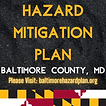HAZARD RISK & VULNERABILITY
HAZARDS
Hazards that have the potential to impact Baltimore County are listed below. These hazards have been ranked by Stakeholder members, as follows: High, Medium-High, Medium, Medium-Low.

For the complete Hazard Identification & Risk Assessment (HIRA) process, click below.
HISTORIC STRUCTURES
Historic structures were assessed for flood risk and vulnerability. An example map depicting historic structures and the FEMA regulated 1% annual chance floodplain is below.

SOCIAL VULNERABILITY
A social vulnerability analysis has been performed for Baltimore County, the result of which is an index score for every census block in the County. The method for this Social Vulnerability Index (SVI) was originally developed by the Centers for Disease Control and Prevention (CDC) as a tool to help public health officials and emergency response planners identify and map communities that will most likely need support before, during, and after a hazardous event.
Social vulnerability refers to the potential negative effects on communities caused by external stresses on human health. Such stresses include natural or human-caused disasters, or disease outbreaks. Reducing social vulnerability can decrease both human suffering and economic loss.
The index includes a combination of 15 demographic variables that are commonly used to characterize social vulnerability. There are four “indicator groups” for which data has been collected: 1) Socioeconomic Status, 2) Household Composition and Disability, 3) Minority Status and Language, and 4) Housing Type and Transportation. Social vulnerability is measured on a scale from 0 to 1, with 0 being the least socially vulnerable and 1 being the most socially vulnerable. Results from a previous social vulnerability analysis are depicted on the map below.


.png)


